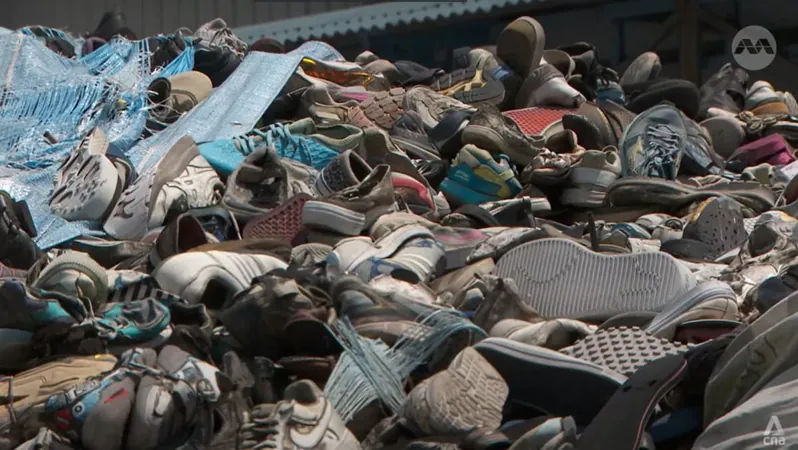
Singapore's Shoe Recycling Initiative Faces a Mountain of Unused Donations: What Went Wrong?
2025-03-17
Author: Arjun
Singapore is facing a growing dilemma as over 300,000 pairs of donated shoes pile up in a Tuas warehouse. Originally intended for recycling into granules for projects like running tracks and playgrounds, the surplus footwear has become a logistical challenge for the program's partners, prompting urgent calls for new initiatives.
The shoe recycling program, launched nearly four years ago as a collaboration between Sport Singapore (SportSG) and the materials science company Dow, aimed to recycle 170,000 pairs of used sports shoes annually. Despite collecting over 400,000 pairs, only 70,000 have found new life across 18 projects, which include a jogging track atop a residential condominium.
The Quest for More Partnerships
Paul Fong, country director of Dow Singapore and Malaysia, emphasized a commitment to diverting these shoes from landfills, particularly to protect the ecological integrity of Semakau Island. "We're focused on recycling instead of discarding," he explained, urging more organizations to join their cause. The project currently partners with four other entities: B T Sports, Alba WH, Decathlon, and Standard Chartered Bank.
Despite these efforts, B T Sports director Hayden Hoon pointed out the stark contrast between donations and the 22 million pairs of shoes purchased annually in Singapore. He remarked, "The number collected is very small in comparison, and the warehouse space taken up by these donations could be used elsewhere."
Quality Concerns: Shoes vs. Tires
While the initiative aims to repurpose shoe materials, experts have raised concerns about the quality control of the final products. Associate Professor Duong Hai Minh from the National University of Singapore noted that the mixed materials in shoes complicate recycling efforts compared to the consistency of rubber tires, which have long been the industry standard for such applications. "Recycling shoes is often more expensive and challenging," he warned, highlighting the superior performance of tire waste in sports surfaces.
Aware of the financial challenges, Hoon recognized that sustainability often comes at a higher cost: "Cheaper alternatives always exist, but long-term benefits must take precedence."
A Call for Strategic Management
Experts believe that to avoid repeating the current scenario of overflowing shoe donations, future initiatives must focus on both supply and demand. Professor Lawrence Loh from NUS Business School stressed the significance of proactive management, including accurate forecasting in donation collection. "It's essential to avoid over-collecting, and proper diligence should ensure that the donations fulfill the original intention of the donors," he stated.
The persistence of over 300,000 pairs of shoes at the Tuas warehouse highlights the complexities of sustainability initiatives, particularly when public interest wanes. As the program seeks alternative solutions and partnerships, one thing is clear—collecting shoes is just the first step; ensuring they are put to effective use remains a significant challenge. Will Singapore rise to the occasion, or will these contributions be lost among the piles?
 Brasil (PT)
Brasil (PT)
 Canada (EN)
Canada (EN)
 Chile (ES)
Chile (ES)
 Česko (CS)
Česko (CS)
 대한민국 (KO)
대한민국 (KO)
 España (ES)
España (ES)
 France (FR)
France (FR)
 Hong Kong (EN)
Hong Kong (EN)
 Italia (IT)
Italia (IT)
 日本 (JA)
日本 (JA)
 Magyarország (HU)
Magyarország (HU)
 Norge (NO)
Norge (NO)
 Polska (PL)
Polska (PL)
 Schweiz (DE)
Schweiz (DE)
 Singapore (EN)
Singapore (EN)
 Sverige (SV)
Sverige (SV)
 Suomi (FI)
Suomi (FI)
 Türkiye (TR)
Türkiye (TR)
 الإمارات العربية المتحدة (AR)
الإمارات العربية المتحدة (AR)